APC308 Financial Management Assignment: Equity and Investment
VerifiedAdded on 2023/01/16
|17
|4292
|82
Homework Assignment
AI Summary
This financial management assignment solution provides a comprehensive analysis of key financial concepts. It begins with an introduction to financial management and its importance in the current business environment, emphasizing strategic planning and resource allocation. The main body addresses two key questions. Question 2(a) delves into long-term finance, specifically equity finance, analyzing the issuance of right shares and evaluating different right issue prices. The solution calculates the number of shares to be issued, the theoretical ex-rights price, and the anticipated earnings per share (EPS) under various scenarios. It then evaluates the best right issue option based on the analysis. Question 2(c) evaluates the benefits of scrip dividends for both shareholders and companies, discussing advantages like maintaining cash positions and tax benefits. Question 3 focuses on investment appraisal techniques, including the payback period and accounting rate of return (ARR). The solution provides formulas and calculations for both, illustrating their application in evaluating investment viability. The assignment concludes with a summary of the key findings and insights.

Financial
Management
Management
Paraphrase This Document
Need a fresh take? Get an instant paraphrase of this document with our AI Paraphraser
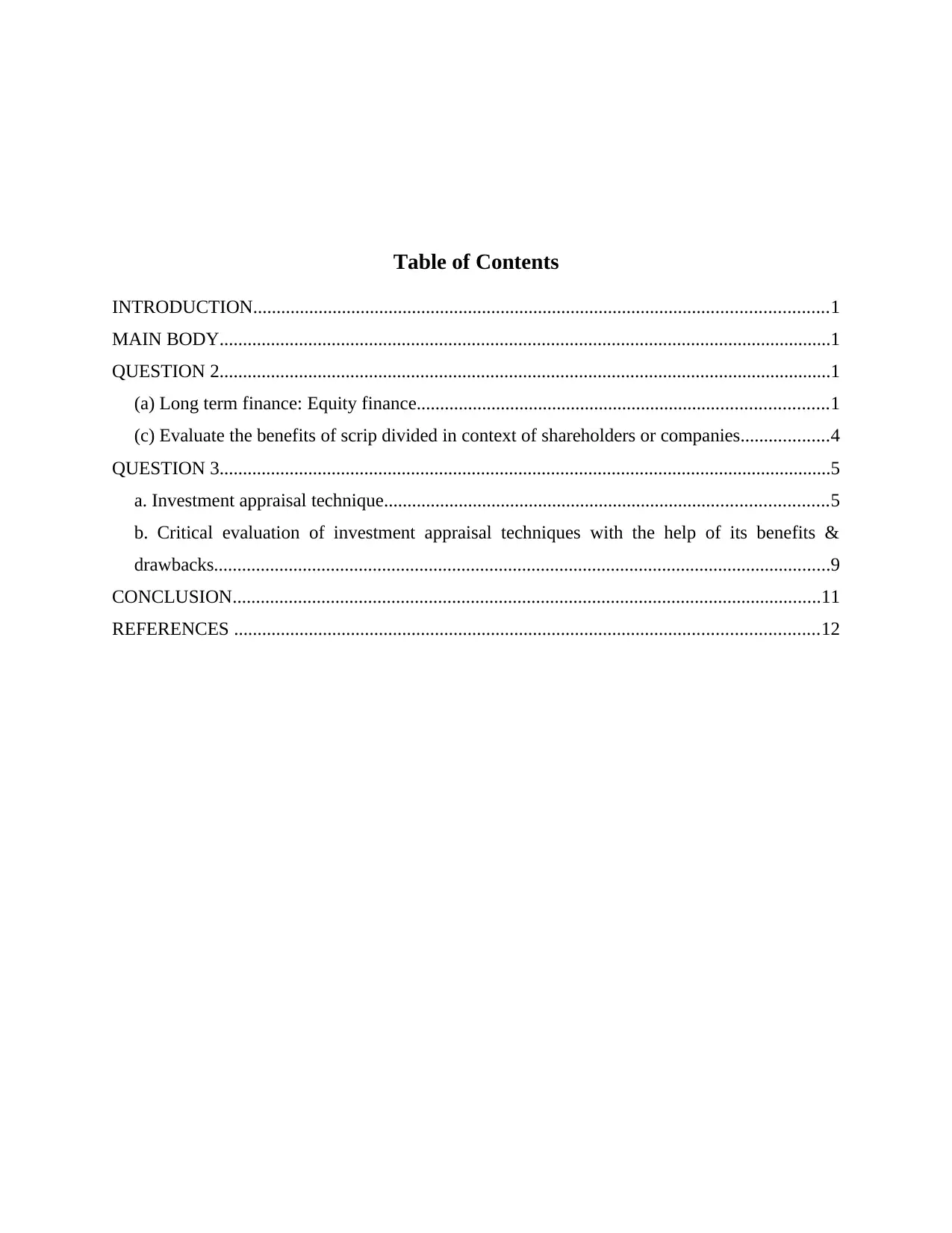
Table of Contents
INTRODUCTION...........................................................................................................................1
MAIN BODY...................................................................................................................................1
QUESTION 2...................................................................................................................................1
(a) Long term finance: Equity finance........................................................................................1
(c) Evaluate the benefits of scrip divided in context of shareholders or companies...................4
QUESTION 3...................................................................................................................................5
a. Investment appraisal technique...............................................................................................5
b. Critical evaluation of investment appraisal techniques with the help of its benefits &
drawbacks....................................................................................................................................9
CONCLUSION..............................................................................................................................11
REFERENCES .............................................................................................................................12
INTRODUCTION...........................................................................................................................1
MAIN BODY...................................................................................................................................1
QUESTION 2...................................................................................................................................1
(a) Long term finance: Equity finance........................................................................................1
(c) Evaluate the benefits of scrip divided in context of shareholders or companies...................4
QUESTION 3...................................................................................................................................5
a. Investment appraisal technique...............................................................................................5
b. Critical evaluation of investment appraisal techniques with the help of its benefits &
drawbacks....................................................................................................................................9
CONCLUSION..............................................................................................................................11
REFERENCES .............................................................................................................................12

⊘ This is a preview!⊘
Do you want full access?
Subscribe today to unlock all pages.

Trusted by 1+ million students worldwide
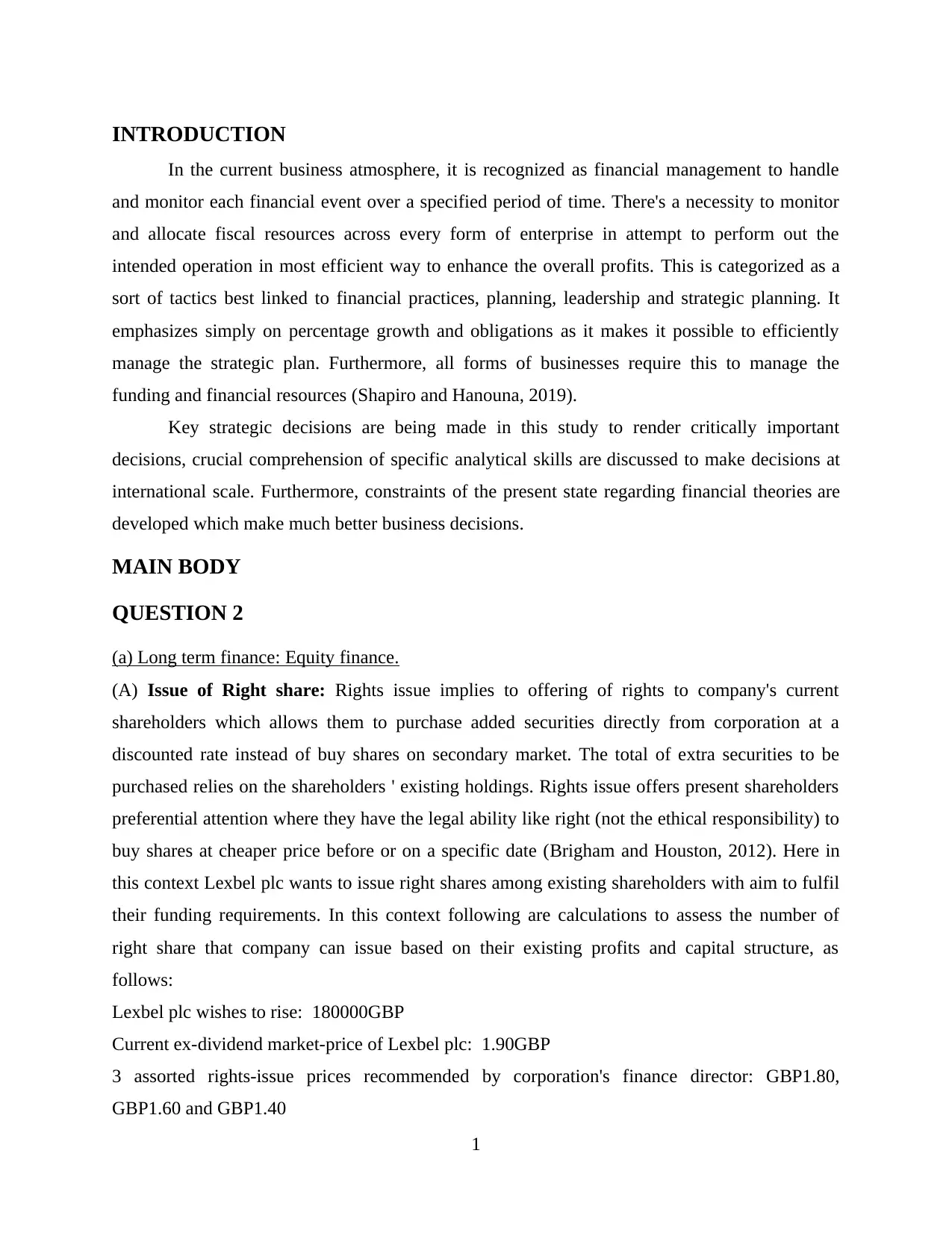
INTRODUCTION
In the current business atmosphere, it is recognized as financial management to handle
and monitor each financial event over a specified period of time. There's a necessity to monitor
and allocate fiscal resources across every form of enterprise in attempt to perform out the
intended operation in most efficient way to enhance the overall profits. This is categorized as a
sort of tactics best linked to financial practices, planning, leadership and strategic planning. It
emphasizes simply on percentage growth and obligations as it makes it possible to efficiently
manage the strategic plan. Furthermore, all forms of businesses require this to manage the
funding and financial resources (Shapiro and Hanouna, 2019).
Key strategic decisions are being made in this study to render critically important
decisions, crucial comprehension of specific analytical skills are discussed to make decisions at
international scale. Furthermore, constraints of the present state regarding financial theories are
developed which make much better business decisions.
MAIN BODY
QUESTION 2
(a) Long term finance: Equity finance.
(A) Issue of Right share: Rights issue implies to offering of rights to company's current
shareholders which allows them to purchase added securities directly from corporation at a
discounted rate instead of buy shares on secondary market. The total of extra securities to be
purchased relies on the shareholders ' existing holdings. Rights issue offers present shareholders
preferential attention where they have the legal ability like right (not the ethical responsibility) to
buy shares at cheaper price before or on a specific date (Brigham and Houston, 2012). Here in
this context Lexbel plc wants to issue right shares among existing shareholders with aim to fulfil
their funding requirements. In this context following are calculations to assess the number of
right share that company can issue based on their existing profits and capital structure, as
follows:
Lexbel plc wishes to rise: 180000GBP
Current ex-dividend market-price of Lexbel plc: 1.90GBP
3 assorted rights-issue prices recommended by corporation's finance director: GBP1.80,
GBP1.60 and GBP1.40
1
In the current business atmosphere, it is recognized as financial management to handle
and monitor each financial event over a specified period of time. There's a necessity to monitor
and allocate fiscal resources across every form of enterprise in attempt to perform out the
intended operation in most efficient way to enhance the overall profits. This is categorized as a
sort of tactics best linked to financial practices, planning, leadership and strategic planning. It
emphasizes simply on percentage growth and obligations as it makes it possible to efficiently
manage the strategic plan. Furthermore, all forms of businesses require this to manage the
funding and financial resources (Shapiro and Hanouna, 2019).
Key strategic decisions are being made in this study to render critically important
decisions, crucial comprehension of specific analytical skills are discussed to make decisions at
international scale. Furthermore, constraints of the present state regarding financial theories are
developed which make much better business decisions.
MAIN BODY
QUESTION 2
(a) Long term finance: Equity finance.
(A) Issue of Right share: Rights issue implies to offering of rights to company's current
shareholders which allows them to purchase added securities directly from corporation at a
discounted rate instead of buy shares on secondary market. The total of extra securities to be
purchased relies on the shareholders ' existing holdings. Rights issue offers present shareholders
preferential attention where they have the legal ability like right (not the ethical responsibility) to
buy shares at cheaper price before or on a specific date (Brigham and Houston, 2012). Here in
this context Lexbel plc wants to issue right shares among existing shareholders with aim to fulfil
their funding requirements. In this context following are calculations to assess the number of
right share that company can issue based on their existing profits and capital structure, as
follows:
Lexbel plc wishes to rise: 180000GBP
Current ex-dividend market-price of Lexbel plc: 1.90GBP
3 assorted rights-issue prices recommended by corporation's finance director: GBP1.80,
GBP1.60 and GBP1.40
1
Paraphrase This Document
Need a fresh take? Get an instant paraphrase of this document with our AI Paraphraser
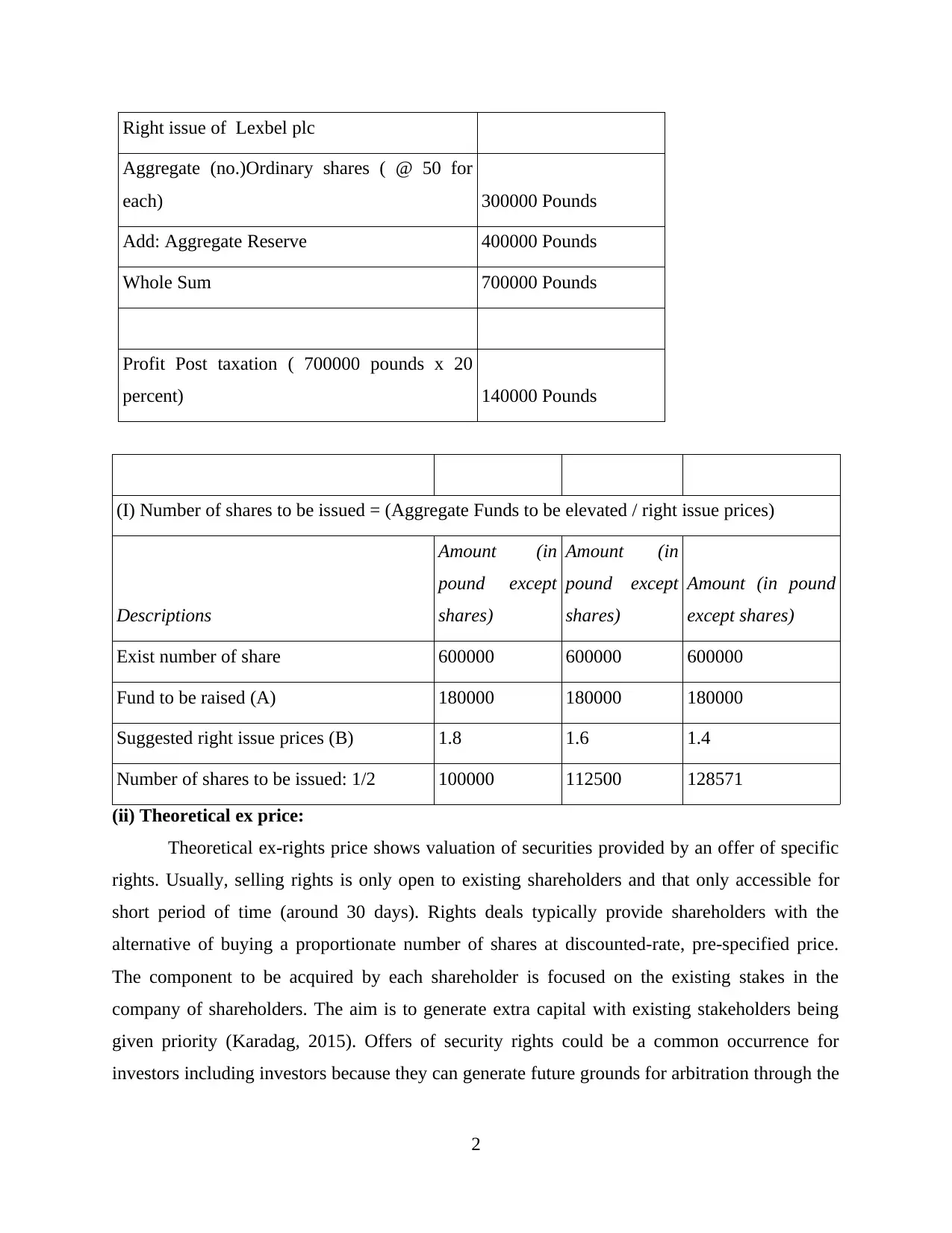
Right issue of Lexbel plc
Aggregate (no.)Ordinary shares ( @ 50 for
each) 300000 Pounds
Add: Aggregate Reserve 400000 Pounds
Whole Sum 700000 Pounds
Profit Post taxation ( 700000 pounds x 20
percent) 140000 Pounds
(I) Number of shares to be issued = (Aggregate Funds to be elevated / right issue prices)
Descriptions
Amount (in
pound except
shares)
Amount (in
pound except
shares)
Amount (in pound
except shares)
Exist number of share 600000 600000 600000
Fund to be raised (A) 180000 180000 180000
Suggested right issue prices (B) 1.8 1.6 1.4
Number of shares to be issued: 1/2 100000 112500 128571
(ii) Theoretical ex price:
Theoretical ex-rights price shows valuation of securities provided by an offer of specific
rights. Usually, selling rights is only open to existing shareholders and that only accessible for
short period of time (around 30 days). Rights deals typically provide shareholders with the
alternative of buying a proportionate number of shares at discounted-rate, pre-specified price.
The component to be acquired by each shareholder is focused on the existing stakes in the
company of shareholders. The aim is to generate extra capital with existing stakeholders being
given priority (Karadag, 2015). Offers of security rights could be a common occurrence for
investors including investors because they can generate future grounds for arbitration through the
2
Aggregate (no.)Ordinary shares ( @ 50 for
each) 300000 Pounds
Add: Aggregate Reserve 400000 Pounds
Whole Sum 700000 Pounds
Profit Post taxation ( 700000 pounds x 20
percent) 140000 Pounds
(I) Number of shares to be issued = (Aggregate Funds to be elevated / right issue prices)
Descriptions
Amount (in
pound except
shares)
Amount (in
pound except
shares)
Amount (in pound
except shares)
Exist number of share 600000 600000 600000
Fund to be raised (A) 180000 180000 180000
Suggested right issue prices (B) 1.8 1.6 1.4
Number of shares to be issued: 1/2 100000 112500 128571
(ii) Theoretical ex price:
Theoretical ex-rights price shows valuation of securities provided by an offer of specific
rights. Usually, selling rights is only open to existing shareholders and that only accessible for
short period of time (around 30 days). Rights deals typically provide shareholders with the
alternative of buying a proportionate number of shares at discounted-rate, pre-specified price.
The component to be acquired by each shareholder is focused on the existing stakes in the
company of shareholders. The aim is to generate extra capital with existing stakeholders being
given priority (Karadag, 2015). Offers of security rights could be a common occurrence for
investors including investors because they can generate future grounds for arbitration through the
2
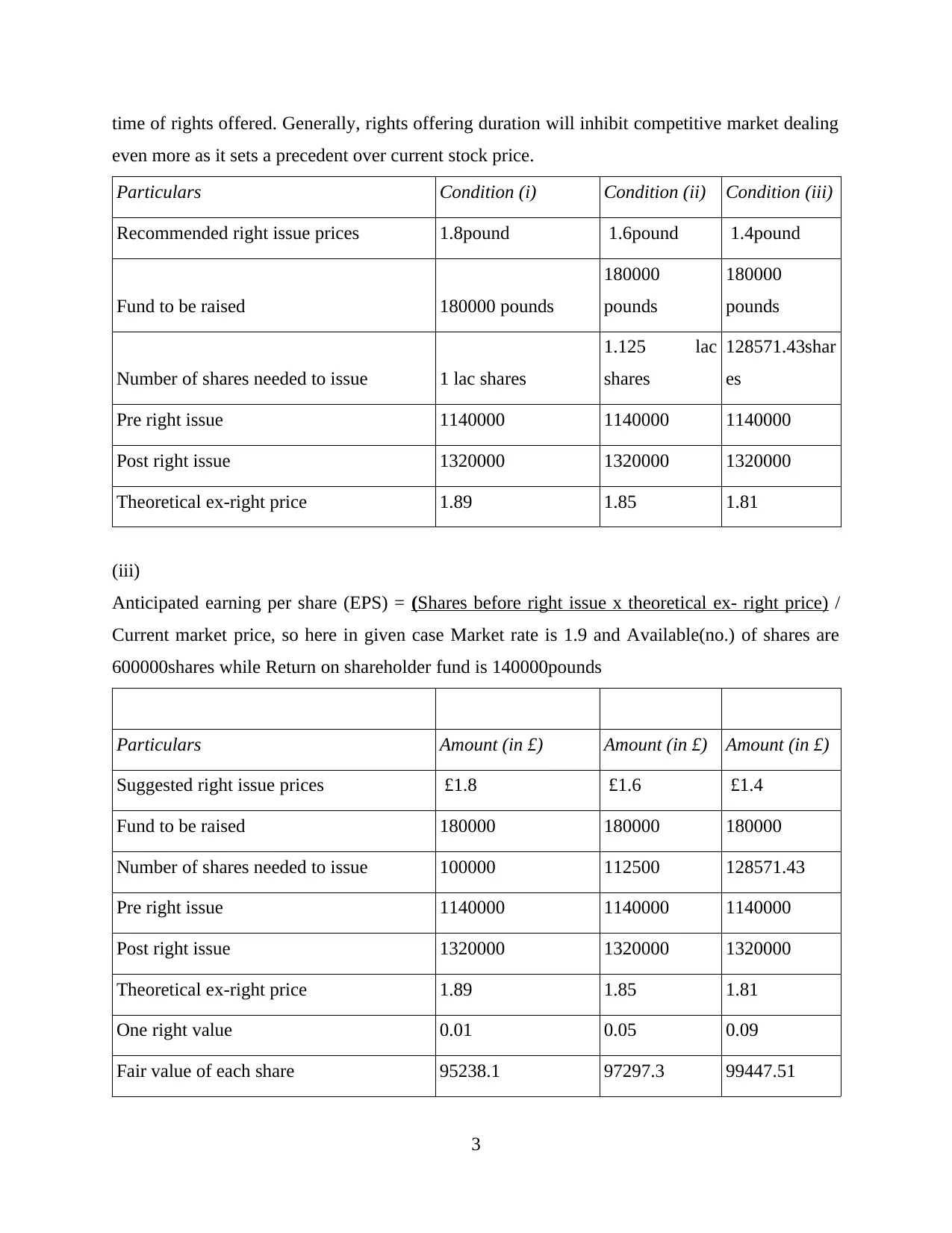
time of rights offered. Generally, rights offering duration will inhibit competitive market dealing
even more as it sets a precedent over current stock price.
Particulars Condition (i) Condition (ii) Condition (iii)
Recommended right issue prices 1.8pound 1.6pound 1.4pound
Fund to be raised 180000 pounds
180000
pounds
180000
pounds
Number of shares needed to issue 1 lac shares
1.125 lac
shares
128571.43shar
es
Pre right issue 1140000 1140000 1140000
Post right issue 1320000 1320000 1320000
Theoretical ex-right price 1.89 1.85 1.81
(iii)
Anticipated earning per share (EPS) = (Shares before right issue x theoretical ex- right price) /
Current market price, so here in given case Market rate is 1.9 and Available(no.) of shares are
600000shares while Return on shareholder fund is 140000pounds
Particulars Amount (in £) Amount (in £) Amount (in £)
Suggested right issue prices £1.8 £1.6 £1.4
Fund to be raised 180000 180000 180000
Number of shares needed to issue 100000 112500 128571.43
Pre right issue 1140000 1140000 1140000
Post right issue 1320000 1320000 1320000
Theoretical ex-right price 1.89 1.85 1.81
One right value 0.01 0.05 0.09
Fair value of each share 95238.1 97297.3 99447.51
3
even more as it sets a precedent over current stock price.
Particulars Condition (i) Condition (ii) Condition (iii)
Recommended right issue prices 1.8pound 1.6pound 1.4pound
Fund to be raised 180000 pounds
180000
pounds
180000
pounds
Number of shares needed to issue 1 lac shares
1.125 lac
shares
128571.43shar
es
Pre right issue 1140000 1140000 1140000
Post right issue 1320000 1320000 1320000
Theoretical ex-right price 1.89 1.85 1.81
(iii)
Anticipated earning per share (EPS) = (Shares before right issue x theoretical ex- right price) /
Current market price, so here in given case Market rate is 1.9 and Available(no.) of shares are
600000shares while Return on shareholder fund is 140000pounds
Particulars Amount (in £) Amount (in £) Amount (in £)
Suggested right issue prices £1.8 £1.6 £1.4
Fund to be raised 180000 180000 180000
Number of shares needed to issue 100000 112500 128571.43
Pre right issue 1140000 1140000 1140000
Post right issue 1320000 1320000 1320000
Theoretical ex-right price 1.89 1.85 1.81
One right value 0.01 0.05 0.09
Fair value of each share 95238.1 97297.3 99447.51
3
⊘ This is a preview!⊘
Do you want full access?
Subscribe today to unlock all pages.

Trusted by 1+ million students worldwide

Bonus fraction 50390.53 52593.14 54943.38
Expected earning per share (EPS) GBP 1.8 GBP 1.6 GBP 1.4
(iv) Form of issue of right issue price:
Particulars Amount (in £) Amount (in £) Amount (in £)
Suggested right issue prices 1.8 1.6 1.4
Fund to be raised 180000 180000 180000
Number of shares to be issued: 100000 112500 128571.43
Exist number of share 600000 600000 600000
Ratio of new-shares to existing-share 24.14% 24.70% 24.16%
Issue proportion of right shares holding
by existing shareholders
Issue of 1 :for 6
right shares held
Issue of 9 :for
48 right shares
held
Issue of 3 :for
14 right shares
held
Critical evaluation:
From above table's interpretation it has been evaluated that there are following three situation in
context of Issue of right shares with three alternatives, as shown below:
The no. of operationally enriched securities throughout right issue of alternative rate of
1.80 will be 1 lac shares of each share. Shareholders should therefore assign the pro-rata
1 share to the remaining six shares.
In second situation with alternative of 1.6 pound per share share are required to be issued
are 112500 so here based on pro-rata 9 shares will be allocated against 48 right shares
issued. While in third situation with 1.4 pound each share no. of shares to be issued are
128571.43 thus based on prorata Issue 3 are offered against 14 right share to existing
shareholders.
(v) Evaluate the best option from three right issue:
Form analysis of above three alternatives it has been analysed that suggested value of
right share of 1.8 pound for each share would be much more advantageous comparatively
respective corporation since the projected earning per share (EPS) in such a case is greater than
other 2 alternative price options.
4
Expected earning per share (EPS) GBP 1.8 GBP 1.6 GBP 1.4
(iv) Form of issue of right issue price:
Particulars Amount (in £) Amount (in £) Amount (in £)
Suggested right issue prices 1.8 1.6 1.4
Fund to be raised 180000 180000 180000
Number of shares to be issued: 100000 112500 128571.43
Exist number of share 600000 600000 600000
Ratio of new-shares to existing-share 24.14% 24.70% 24.16%
Issue proportion of right shares holding
by existing shareholders
Issue of 1 :for 6
right shares held
Issue of 9 :for
48 right shares
held
Issue of 3 :for
14 right shares
held
Critical evaluation:
From above table's interpretation it has been evaluated that there are following three situation in
context of Issue of right shares with three alternatives, as shown below:
The no. of operationally enriched securities throughout right issue of alternative rate of
1.80 will be 1 lac shares of each share. Shareholders should therefore assign the pro-rata
1 share to the remaining six shares.
In second situation with alternative of 1.6 pound per share share are required to be issued
are 112500 so here based on pro-rata 9 shares will be allocated against 48 right shares
issued. While in third situation with 1.4 pound each share no. of shares to be issued are
128571.43 thus based on prorata Issue 3 are offered against 14 right share to existing
shareholders.
(v) Evaluate the best option from three right issue:
Form analysis of above three alternatives it has been analysed that suggested value of
right share of 1.8 pound for each share would be much more advantageous comparatively
respective corporation since the projected earning per share (EPS) in such a case is greater than
other 2 alternative price options.
4
Paraphrase This Document
Need a fresh take? Get an instant paraphrase of this document with our AI Paraphraser
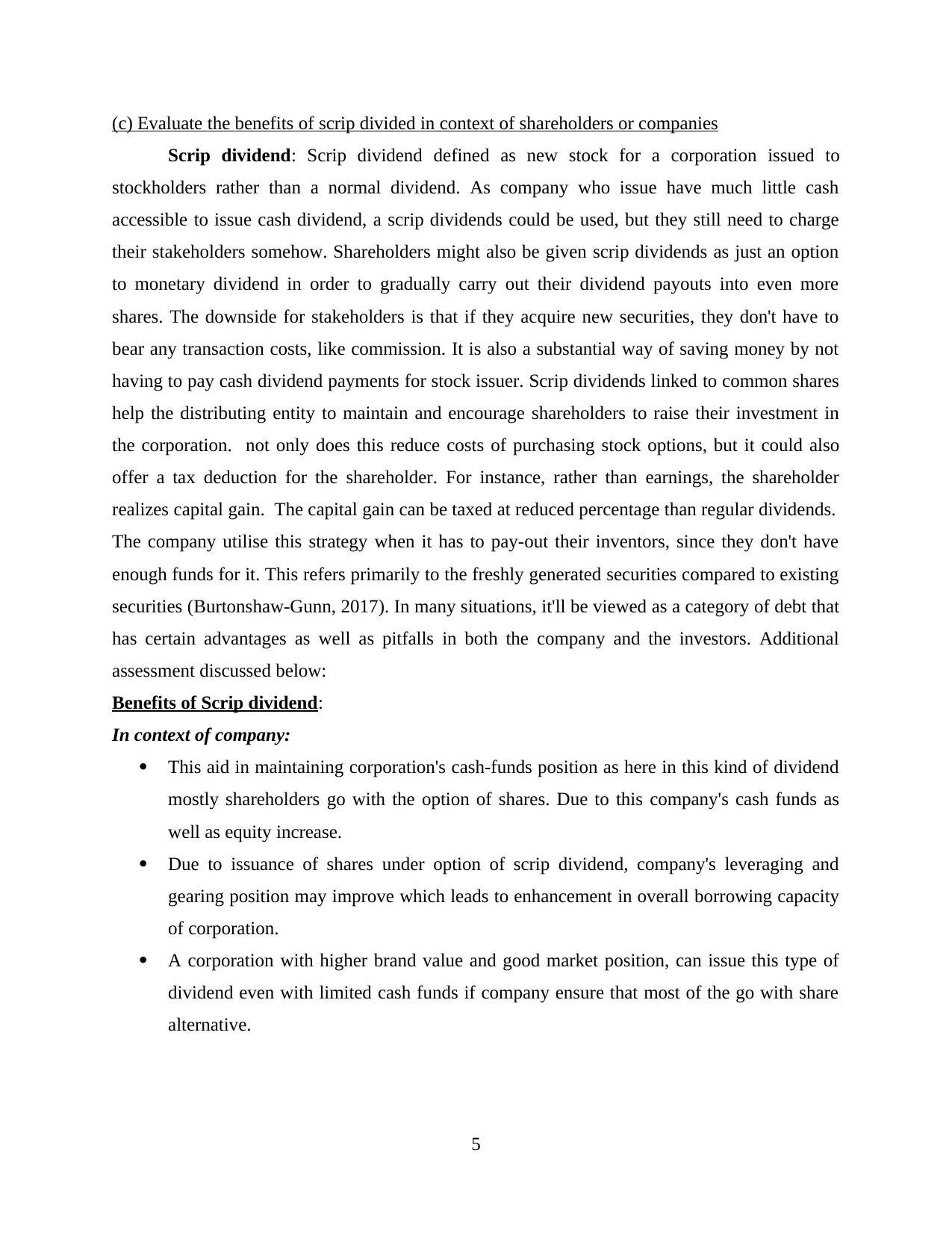
(c) Evaluate the benefits of scrip divided in context of shareholders or companies
Scrip dividend: Scrip dividend defined as new stock for a corporation issued to
stockholders rather than a normal dividend. As company who issue have much little cash
accessible to issue cash dividend, a scrip dividends could be used, but they still need to charge
their stakeholders somehow. Shareholders might also be given scrip dividends as just an option
to monetary dividend in order to gradually carry out their dividend payouts into even more
shares. The downside for stakeholders is that if they acquire new securities, they don't have to
bear any transaction costs, like commission. It is also a substantial way of saving money by not
having to pay cash dividend payments for stock issuer. Scrip dividends linked to common shares
help the distributing entity to maintain and encourage shareholders to raise their investment in
the corporation. not only does this reduce costs of purchasing stock options, but it could also
offer a tax deduction for the shareholder. For instance, rather than earnings, the shareholder
realizes capital gain. The capital gain can be taxed at reduced percentage than regular dividends.
The company utilise this strategy when it has to pay-out their inventors, since they don't have
enough funds for it. This refers primarily to the freshly generated securities compared to existing
securities (Burtonshaw-Gunn, 2017). In many situations, it'll be viewed as a category of debt that
has certain advantages as well as pitfalls in both the company and the investors. Additional
assessment discussed below:
Benefits of Scrip dividend:
In context of company:
This aid in maintaining corporation's cash-funds position as here in this kind of dividend
mostly shareholders go with the option of shares. Due to this company's cash funds as
well as equity increase.
Due to issuance of shares under option of scrip dividend, company's leveraging and
gearing position may improve which leads to enhancement in overall borrowing capacity
of corporation.
A corporation with higher brand value and good market position, can issue this type of
dividend even with limited cash funds if company ensure that most of the go with share
alternative.
5
Scrip dividend: Scrip dividend defined as new stock for a corporation issued to
stockholders rather than a normal dividend. As company who issue have much little cash
accessible to issue cash dividend, a scrip dividends could be used, but they still need to charge
their stakeholders somehow. Shareholders might also be given scrip dividends as just an option
to monetary dividend in order to gradually carry out their dividend payouts into even more
shares. The downside for stakeholders is that if they acquire new securities, they don't have to
bear any transaction costs, like commission. It is also a substantial way of saving money by not
having to pay cash dividend payments for stock issuer. Scrip dividends linked to common shares
help the distributing entity to maintain and encourage shareholders to raise their investment in
the corporation. not only does this reduce costs of purchasing stock options, but it could also
offer a tax deduction for the shareholder. For instance, rather than earnings, the shareholder
realizes capital gain. The capital gain can be taxed at reduced percentage than regular dividends.
The company utilise this strategy when it has to pay-out their inventors, since they don't have
enough funds for it. This refers primarily to the freshly generated securities compared to existing
securities (Burtonshaw-Gunn, 2017). In many situations, it'll be viewed as a category of debt that
has certain advantages as well as pitfalls in both the company and the investors. Additional
assessment discussed below:
Benefits of Scrip dividend:
In context of company:
This aid in maintaining corporation's cash-funds position as here in this kind of dividend
mostly shareholders go with the option of shares. Due to this company's cash funds as
well as equity increase.
Due to issuance of shares under option of scrip dividend, company's leveraging and
gearing position may improve which leads to enhancement in overall borrowing capacity
of corporation.
A corporation with higher brand value and good market position, can issue this type of
dividend even with limited cash funds if company ensure that most of the go with share
alternative.
5

Another advantageous thing here is that smaller scrip dividend issuance generally not
dilutes company's share price majorly. Although where company is not offering cash as
an alternate, experiential grounds proposes that shares' price will be fall. It also a significant source of finance and funding due to option of shares against
dividend.
In context of shareholders:
Most prime advantage for shareholders, of a scrip dividend is that they can get tax
advantages by adopting the option/alternative of shares.
Shareholder who have desire to make an increase in their shareholding in company this
dividend is beneficial as they can enhance shareholding without any additional
transaction costs.
Share option in scrip dividend may provide a greater monetary benefits as compare to
cash dividend so mostly shareholders wants to get scrip dividend.
QUESTION 3
a. Investment appraisal technique
(I) Payback Period:
This is a capital budgeting technique that is meant to assess the new
investment's viability and to support the individual decision of selection of most appropriate
investment alternative. Payback period defined as specific duration over which the company will
reimburse the amount of money invested. Minimal payback duration is advantageous to the
organization as it allows to retrieve initial investment and commence to generate yields on it. It
allows managers to assess whether investment made on any option is capable to return back
within a reasonable period. Payback period is mandated to recuperate negative
project/venture cash from the purchase and/or initial years for positive project/venture cash flow.
Payback may be measured either from beginning of a proposal or from beginning of production
process. Payback periods are usually measured on the basis of undiscounted cash-flows, but it
may even be estimated at minimum return rate(%) for Discounted Cash Flows (Arnold, 2012).
The insight that investor wants to retrieve the spent capital at the earliest opportunity is driving
payback measures. Below is specific formula for computation of payback period, as follows:
Formula: Payback Period = Initial investment / cash inflow
6
dilutes company's share price majorly. Although where company is not offering cash as
an alternate, experiential grounds proposes that shares' price will be fall. It also a significant source of finance and funding due to option of shares against
dividend.
In context of shareholders:
Most prime advantage for shareholders, of a scrip dividend is that they can get tax
advantages by adopting the option/alternative of shares.
Shareholder who have desire to make an increase in their shareholding in company this
dividend is beneficial as they can enhance shareholding without any additional
transaction costs.
Share option in scrip dividend may provide a greater monetary benefits as compare to
cash dividend so mostly shareholders wants to get scrip dividend.
QUESTION 3
a. Investment appraisal technique
(I) Payback Period:
This is a capital budgeting technique that is meant to assess the new
investment's viability and to support the individual decision of selection of most appropriate
investment alternative. Payback period defined as specific duration over which the company will
reimburse the amount of money invested. Minimal payback duration is advantageous to the
organization as it allows to retrieve initial investment and commence to generate yields on it. It
allows managers to assess whether investment made on any option is capable to return back
within a reasonable period. Payback period is mandated to recuperate negative
project/venture cash from the purchase and/or initial years for positive project/venture cash flow.
Payback may be measured either from beginning of a proposal or from beginning of production
process. Payback periods are usually measured on the basis of undiscounted cash-flows, but it
may even be estimated at minimum return rate(%) for Discounted Cash Flows (Arnold, 2012).
The insight that investor wants to retrieve the spent capital at the earliest opportunity is driving
payback measures. Below is specific formula for computation of payback period, as follows:
Formula: Payback Period = Initial investment / cash inflow
6
⊘ This is a preview!⊘
Do you want full access?
Subscribe today to unlock all pages.

Trusted by 1+ million students worldwide

Calculation as accordance of investment appraisal techniques.
(I) Payback period
Initial investment 275000
Cash inflow 85000
Cash outflow 12500
Cash flow 72500
Payback period 3.79
(ii) Accounting rate of return:
ARR reported as percentage of projected investment returns company will get. This is
another of simplest or fastest way of investment evaluation that the company usually uses with
project selection. The total income is measured by dividing this from initial investment. ARR is
technique of capital budgeting that does not accurately reflect the time's value of money and
cashflows. The more the return appears advantageous to the corporation, meaning company
receives the better yields, while the weaker return isn't really beneficial. Organization measures
the results of several projects and choices are made directly by executives. The table in the below
shows the simple calculation method of ARR for period of 6 years in which the relevant return is
obtained (Cangiano, Curristine and Lazare, 2013). Thus, the corporation's executives have to
devise their tactics accordingly as well as decide to choose whether or not pick this venture
for investment. Following are the ARR computations, as follows:
Formula: Accounting rate of return = Average annual profit / Initial investment * 100
Cash inflow £85,000
Cash outflow £12,500
Net cash flow
(Cash inflow – Cash outflow) £75,500
7
(I) Payback period
Initial investment 275000
Cash inflow 85000
Cash outflow 12500
Cash flow 72500
Payback period 3.79
(ii) Accounting rate of return:
ARR reported as percentage of projected investment returns company will get. This is
another of simplest or fastest way of investment evaluation that the company usually uses with
project selection. The total income is measured by dividing this from initial investment. ARR is
technique of capital budgeting that does not accurately reflect the time's value of money and
cashflows. The more the return appears advantageous to the corporation, meaning company
receives the better yields, while the weaker return isn't really beneficial. Organization measures
the results of several projects and choices are made directly by executives. The table in the below
shows the simple calculation method of ARR for period of 6 years in which the relevant return is
obtained (Cangiano, Curristine and Lazare, 2013). Thus, the corporation's executives have to
devise their tactics accordingly as well as decide to choose whether or not pick this venture
for investment. Following are the ARR computations, as follows:
Formula: Accounting rate of return = Average annual profit / Initial investment * 100
Cash inflow £85,000
Cash outflow £12,500
Net cash flow
(Cash inflow – Cash outflow) £75,500
7
Paraphrase This Document
Need a fresh take? Get an instant paraphrase of this document with our AI Paraphraser

Step 1
Year £ Net cash flows
£ Residual
value £ Depreciation
Annual
profit
1 72,500 0 38,958.33 33,541.67
2 72,500 0 38,958.33 33,541.67
3 72,500 0 38,958.33 33,541.67
4 72,500 0 38,958.33 33,541.67
5 72,500 0 38,958.33 33,541.67
6(Cash flows + residual
value –year depreciation) 72,500 41,250 38,958.33 74,791.67
Step 2
Average profit = (year 1+…+year 6 profit) / numbers of years
£242,500.02 / 6 = £ 40,416.67
Step 3
Average capital = (initial cost + residual value) / 2 = (£275,000 + £41,250) / 2= £158,125
Step 4
ARR= Step2 / Step3 * 100% = £40,416.67 / £158,125 *100% = 25.56 % profitability
(iii) Net present value (NPV): NPV corresponds to a proposal's net present value, this is main
method that organisations commonly use to make decisions. It includes a profound cash inflow
evaluation that occurs at distinct periods of time. A project's NPV is computed by introducing all
cash in-flows as well as out-flows to PVs (present values). Cash inflows get a constructive
symbol whereas cash outflows get a negative symbol. Furthermore, the discounted rate element
of cash-flow is the most crucial aspect necessary for analysing and considering the net present
value in calculation. The NPV is a statistic that can decide if a financial move is an investing
opportunity or not. This is simply a present-value of all cash-flows (with net cash flows
including net outflows), that also means NPV could be called an income formula minus
expenditures (Jindrichovska, 2013). When NPV is positive-value, that implies revenue worth
8
Year £ Net cash flows
£ Residual
value £ Depreciation
Annual
profit
1 72,500 0 38,958.33 33,541.67
2 72,500 0 38,958.33 33,541.67
3 72,500 0 38,958.33 33,541.67
4 72,500 0 38,958.33 33,541.67
5 72,500 0 38,958.33 33,541.67
6(Cash flows + residual
value –year depreciation) 72,500 41,250 38,958.33 74,791.67
Step 2
Average profit = (year 1+…+year 6 profit) / numbers of years
£242,500.02 / 6 = £ 40,416.67
Step 3
Average capital = (initial cost + residual value) / 2 = (£275,000 + £41,250) / 2= £158,125
Step 4
ARR= Step2 / Step3 * 100% = £40,416.67 / £158,125 *100% = 25.56 % profitability
(iii) Net present value (NPV): NPV corresponds to a proposal's net present value, this is main
method that organisations commonly use to make decisions. It includes a profound cash inflow
evaluation that occurs at distinct periods of time. A project's NPV is computed by introducing all
cash in-flows as well as out-flows to PVs (present values). Cash inflows get a constructive
symbol whereas cash outflows get a negative symbol. Furthermore, the discounted rate element
of cash-flow is the most crucial aspect necessary for analysing and considering the net present
value in calculation. The NPV is a statistic that can decide if a financial move is an investing
opportunity or not. This is simply a present-value of all cash-flows (with net cash flows
including net outflows), that also means NPV could be called an income formula minus
expenditures (Jindrichovska, 2013). When NPV is positive-value, that implies revenue worth
8
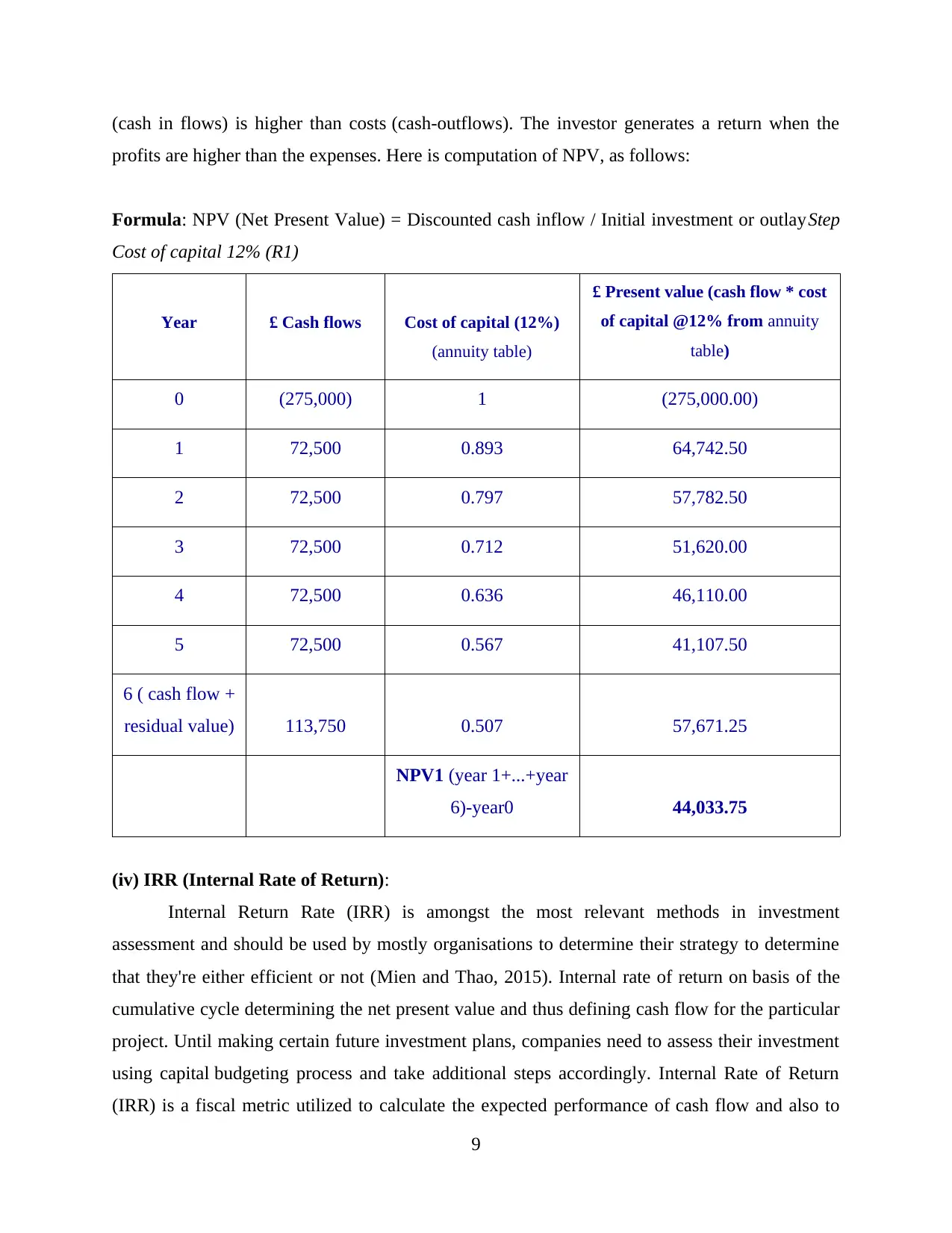
(cash in flows) is higher than costs (cash-outflows). The investor generates a return when the
profits are higher than the expenses. Here is computation of NPV, as follows:
Formula: NPV (Net Present Value) = Discounted cash inflow / Initial investment or outlayStep
Cost of capital 12% (R1)
Year £ Cash flows Cost of capital (12%)
(annuity table)
£ Present value (cash flow * cost
of capital @12% from annuity
table)
0 (275,000) 1 (275,000.00)
1 72,500 0.893 64,742.50
2 72,500 0.797 57,782.50
3 72,500 0.712 51,620.00
4 72,500 0.636 46,110.00
5 72,500 0.567 41,107.50
6 ( cash flow +
residual value) 113,750 0.507 57,671.25
NPV1 (year 1+...+year
6)-year0 44,033.75
(iv) IRR (Internal Rate of Return):
Internal Return Rate (IRR) is amongst the most relevant methods in investment
assessment and should be used by mostly organisations to determine their strategy to determine
that they're either efficient or not (Mien and Thao, 2015). Internal rate of return on basis of the
cumulative cycle determining the net present value and thus defining cash flow for the particular
project. Until making certain future investment plans, companies need to assess their investment
using capital budgeting process and take additional steps accordingly. Internal Rate of Return
(IRR) is a fiscal metric utilized to calculate the expected performance of cash flow and also to
9
profits are higher than the expenses. Here is computation of NPV, as follows:
Formula: NPV (Net Present Value) = Discounted cash inflow / Initial investment or outlayStep
Cost of capital 12% (R1)
Year £ Cash flows Cost of capital (12%)
(annuity table)
£ Present value (cash flow * cost
of capital @12% from annuity
table)
0 (275,000) 1 (275,000.00)
1 72,500 0.893 64,742.50
2 72,500 0.797 57,782.50
3 72,500 0.712 51,620.00
4 72,500 0.636 46,110.00
5 72,500 0.567 41,107.50
6 ( cash flow +
residual value) 113,750 0.507 57,671.25
NPV1 (year 1+...+year
6)-year0 44,033.75
(iv) IRR (Internal Rate of Return):
Internal Return Rate (IRR) is amongst the most relevant methods in investment
assessment and should be used by mostly organisations to determine their strategy to determine
that they're either efficient or not (Mien and Thao, 2015). Internal rate of return on basis of the
cumulative cycle determining the net present value and thus defining cash flow for the particular
project. Until making certain future investment plans, companies need to assess their investment
using capital budgeting process and take additional steps accordingly. Internal Rate of Return
(IRR) is a fiscal metric utilized to calculate the expected performance of cash flow and also to
9
⊘ This is a preview!⊘
Do you want full access?
Subscribe today to unlock all pages.

Trusted by 1+ million students worldwide
1 out of 17
Related Documents
Your All-in-One AI-Powered Toolkit for Academic Success.
+13062052269
info@desklib.com
Available 24*7 on WhatsApp / Email
![[object Object]](/_next/static/media/star-bottom.7253800d.svg)
Unlock your academic potential
Copyright © 2020–2025 A2Z Services. All Rights Reserved. Developed and managed by ZUCOL.




